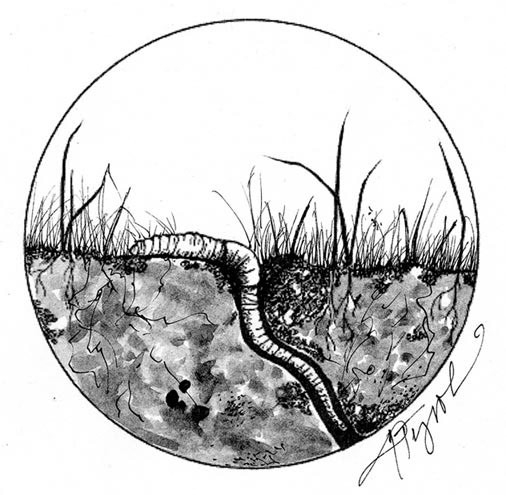
Without legs, wings, eyes, tentacles, or antennae, an earthworm appears almost too simple a creature to do anything. Yet, just for starters, they have well-designed tools for motoring: tiny clusters of ‘non-skid’ bristles scattered along a multi-segmented body that help them in their travels. An earthworm tunnels powerfully through dense soil by first narrowing its muscular body and thrusting ahead, then bunching up its front end to push soil aside and, finally, pulling the rest of its slender body forward. Thrust, bunch and pull—the worm moves through its subterranean world with relative ease.
An earthworm’s underworld consists of deep tunnels and enlarged chambers, where it can curl up or turn around, and where cocoons are left and young get a start in life. The chambers of earthworms may be lined with decaying vegetation, the leftovers of food brought down from the surface. Plant fragments sometimes protrude from a burrow at ground level, the worm having failed to pull all of it in. Sometimes worms find bits of wood or tiny pebbles to block an entrance to their tunnels, which helps preserve underground humidity.
Too much humidity can be hazardous to health, however. Earthworms breathe atmospheric oxygen through their moist skin, so in a downpour they often emerge from their burrows to escape drowning. That’s why after a storm, worms can be found inching along in the grass or mud.
What’s inside an earthworm? Muscles, nerves, blood vessels and blood-chemistry that in many ways resemble that of humans – all suited to meet earthworm needs.
Earthworms have a highly developed nervous system. Light-sensitive cells (they have no eyes as such) are concentrated on the upper side of the front end, the best place to be when the soil-dweller emerges tentatively to test the outside surroundings. Here also are cells that react to physical pressure and others that sample soil chemistry. Their findings go to a brain for interpretation and action. And like vertebrates, earthworms have a brain that produces hormones in times of stress.
Then there’s the closed circulatory system, complete with arteries, veins and capillaries. The earthworm’s blood contains hemoglobin, the red protein that carries oxygen, just as in our blood. But the worm’s ‘heart’ is a body-long blood pump vessel that is aided by five ancillary pairs of contracting vessels, each with flap-like valves to help keep the blood circulating in one direction. (Look closely at the dark line running under the skin along the back of a large earthworm, and you’ll see the vessel pulsating from rear to front.)
Blood vessels in earthworms narrow to capillaries as is the case with humans; and these capillaries pick up oxygen through the skin, and that oxygen is delivered by blood to other parts of the body.
Scientists believe earthworms inhabited the soil of North America millions of years before the massive glacial ice sheets of the Pleistocene Era (1.5 million to 10,000 years ago) arrived and killed them off and that the earthworms we find in our gardens today are the descendants of critters that arrived in the ships of European colonizers and immigrants. The newcomers —some brought here inadvertently, some brought for agricultural reasons—found no shortage of food in their new surroundings and began to thrive.
Earthworms generally are valued by humans – from anglers who use them as bait, to farmers and gardeners who like the fact they aerate and fertilize the soil. Earthworms eat more than surface food: As a kind of ramjet, they travel through the soil swallowing dirt as they go, taking in certain nutrients and excreting nitrogen compounds and organic material beneficial to crop growth. In addition, as soil passes through an earthworm’s gut, it becomes more porous, or sponge-like, and is better able to absorb water.
But there is a downside to earthworm activity. Scientists are now finding that earthworms are harming the northern forest in some places by eating too much duff, the decaying plant matter that lies on the forest floor. Less duff means less nutrients and less opportunity for tree seedlings to germinate. It means fewer trees.
As a newcomer to our shores, the highly developed and enormously active earthworm, with obvious fecundity, is both a blessing and a possible curse.


Discussion *